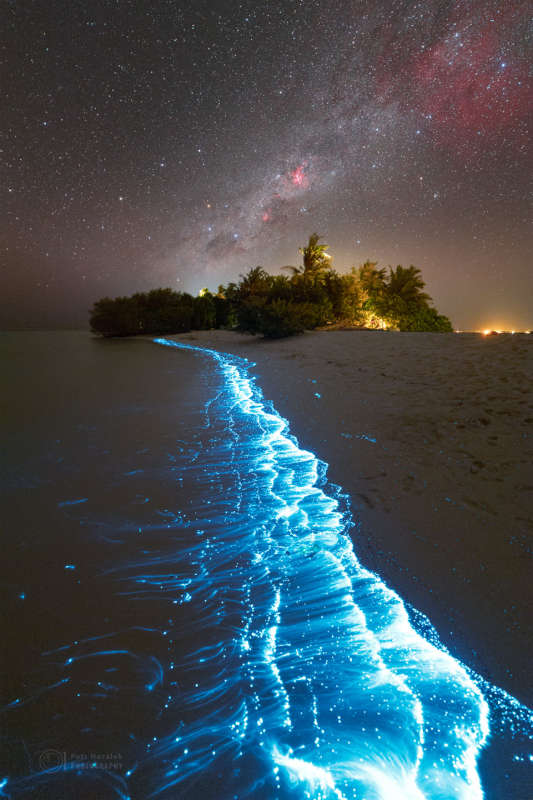
|
Credit & Copyright: Petr Hor÷lek /
Institute of Physics in Opava,
Sovena Jani
Explanation:
What glows there?
The answer depends: sea or sky?
In the sea, the unusual blue glow is
bioluminescence.
Specifically, the glimmer arises from
Noctiluca scintillans, single-celled plankton stimulated by the lapping waves.
The plankton
use their glow to
startle
and illuminate predators.
This mid-February display on an island in the
Maldives was so intense that the astrophotographer
described it as a
turquoise wonderland.
In the sky, by contrast, are the more familiar glows of
stars and
nebulas.
The white band rising from the artificially-illuminated
green
plants is created by billions of stars in the
central disk of our
Milky Way Galaxy.
Also visible in the sky is the star cluster
Omega Centauri, toward the left, and the famous
Southern Cross
asterism in the
center.
Red-glowing nebulas include the bright
Carina Nebula, just right of center, and the expansive
Gum Nebula on the upper right.
|
January February March April May June July August September October November December |
| ||||||||||||||||||||||||||||||||||||||||||||||||
NASA Web Site Statements, Warnings, and Disclaimers
NASA Official: Jay Norris. Specific rights apply.
A service of: LHEA at NASA / GSFC
& Michigan Tech. U.
Based on Astronomy Picture
Of the Day
Publications with keywords: Milky Way
Publications with words: Milky Way
See also:
- APOD: 2025 July 2 ┴ Milky Way Through Otago Spires
- APOD: 2025 May 20 ┴ Milky Way over Maunakea
- APOD: 2025 May 13 ┴ Gaia Reconstructs a Top View of our Galaxy
- APOD: 2025 May 12 ┴ Gaia Reconstructs a Side View of our Galaxy
- Galaxies in Space
- APOD: 2025 February 9 ┴ Milky Way over the Australian Pinnacles
- APOD: 2024 November 24 ┴ Journey to the Center of the Galaxy
